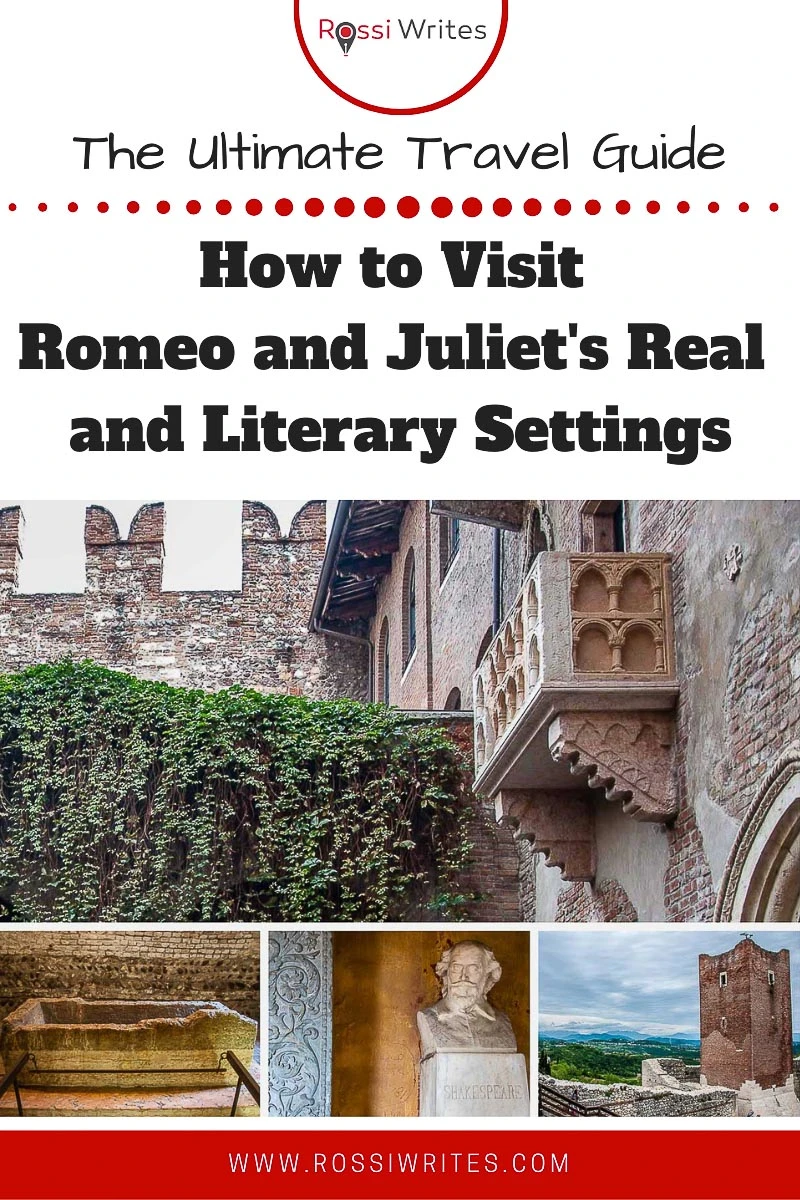‘Romeo and Juliet’ is, undoubtedly, the world’s most famous love story.
And while fair Verona is the literary setting where the two star-crossed lovers meet, fall for each other, and ultimately die, there are over a dozen real places where the story of Romeo and Juliet actually came to life.
First among them are an Italian countryside villa, two hilltop castles, and a small Italian city called Vicenza which is near Verona and often overlooked. Especially, in terms of the story of Romeo and Juliet.
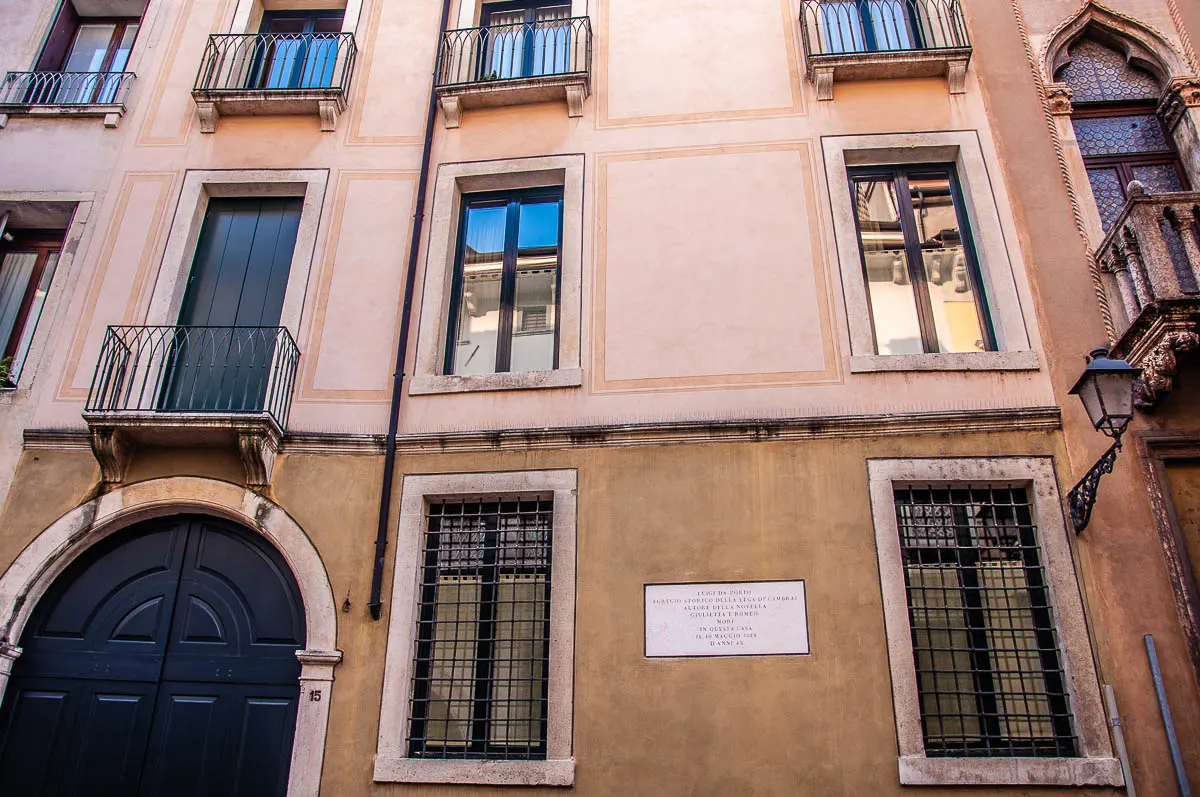
Yet, in a perfect example of life always being much more complicated and multilayered than fiction, these three settings are where Romeo and Juliet first came to exist on the pages of a novel written over 12 years by one Luigi da Porto – a Vicenza nobleman.
Born in 1485, da Porto was a soldier and a man of letters. He fought in the War of the League of Cambrai – the early 16th-century conflict between France, the Papal States, and the Republic of Venice. He wrote poems and stories. And, then, in 1511, at a Venetian ball, he fell in love with his 16-year old cousin – Lucina Savorgnan – after hearing her sing.
It was not a happy love story. Lucina was married off to someone else. Luigi, paralysed and suffering from wounds sustained in the war, retreated to his countryside villa to write.
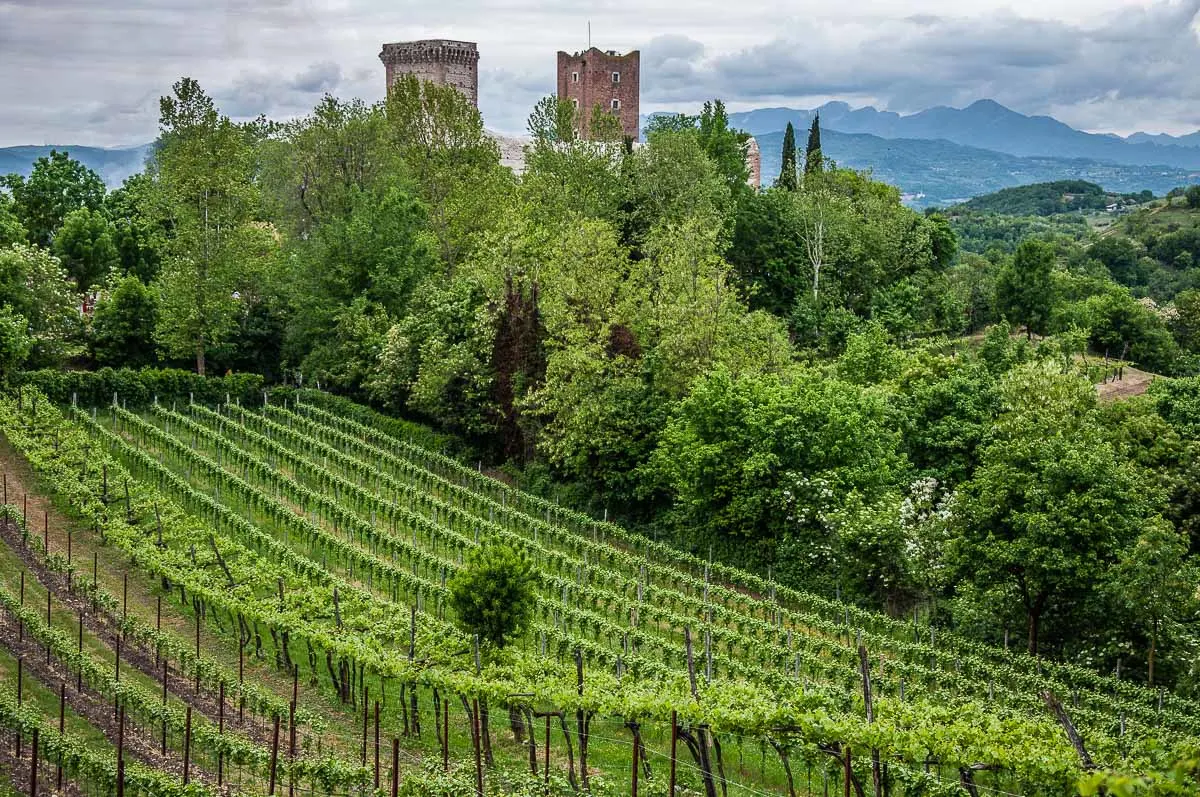
Taking inspiration from his own unhappy love story, other tragic novels that were popular in Italy at that time, and even a legend told to him by his archer, Luigi da Porto penned Historia novellamente ritrovata di due nobili amanti con la pietosa loro morte intervenuta gia’ nella citta’ di Verona nel tempo del Signore Bartolommeo della Scalla (in English: A Story Newly-Found of Two Noble Lovers, with Their Pitiful Death which Happened in the City of Verona during the Reign of Bartolommeo della Scalla). It was in this novel that the characters of Romeo and Juliet first came to life.
The novel was published in 1530 in Venice by Benedetto di Bondoni, after da Porto’s death. It was so successful that it was even translated into English. One way or another, the story must have reached directly or indirectly William Shakespeare for the Bard of Avon then wrote ‘The Most Excellent and Lamentable Tragedy of Romeo and Juliet’ in 1595.
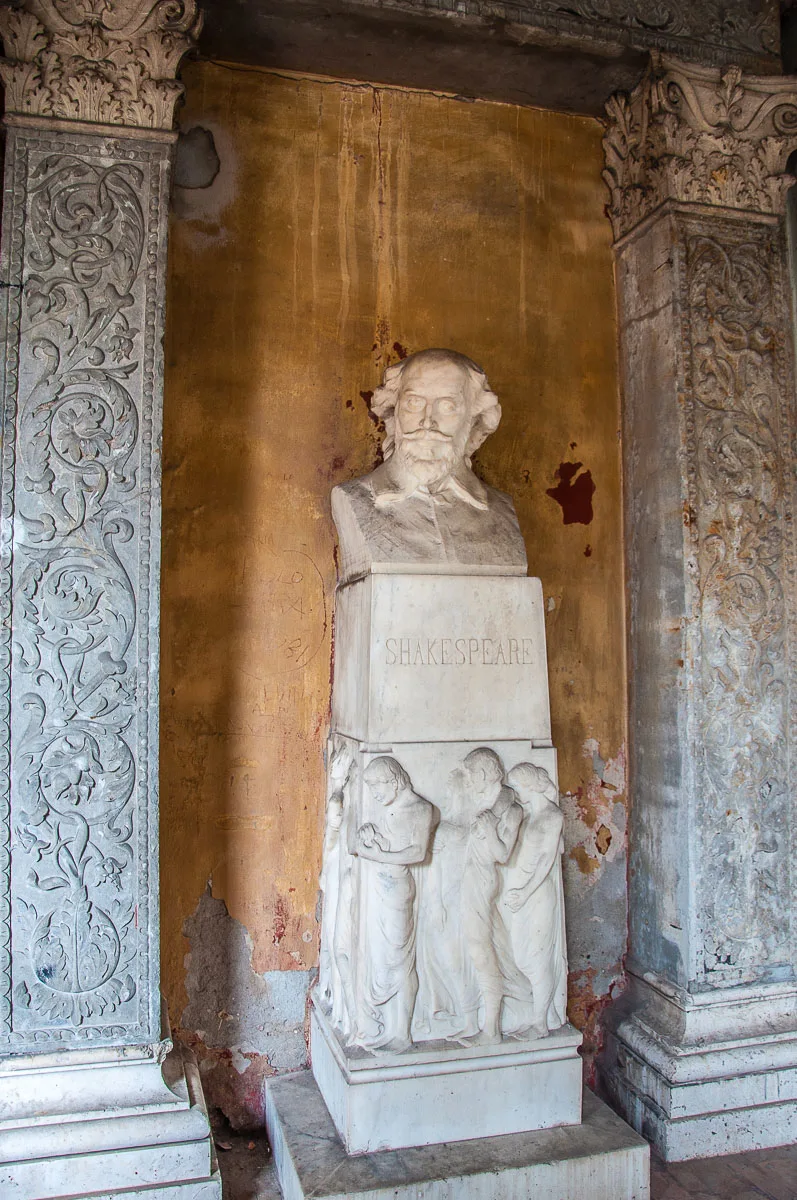
Nowadays, Romeo and Juliet’s story is known all over the world. It has been the subject of numerous films and songs, the inspiration behind poems and acts of love. Yet, as it often happens, its origins are not widely known. Its original settings stay off the beaten path. And while thousands flock to see Juliet’s House each year, the real itinerary of Romeo and Juliet encompasses several evocative sights. Many of them are beyond the walls of fair Verona. They all need to be seen to fully feel the beauty and the sense of doom of the world’s most famous love story.
So, in this blog post today, I want to take you on a walk and show you the real and the literary settings of the story of Romeo and Juliet.
We will start with the villa where Luigi da Porto wrote his book and the two hilltop castles which inspired his pen. We will stop in Vicenza to see the writer’s final resting place and a couple of other pertinent sights. Then we will continue to Verona to take in the landmarks that nowadays are synonymous with Romeo and Juliet. A brief stay in Mantua follows – the city to which Romeo was banished and where, in real life, another writer took the story of Romeo and Juliet in his hands. We will finish this romantic itinerary in England to pay homage to William Shakespeare and his worldwide famous tragic play.
After all, it was Shakespeare’s play that preserved Luigi da Porto’s legacy and made Romeo and Juliet the icons of romantic love that they are nowadays. And this is not a small feat.
Let’s start!
The Ultimate Romeo and Juliet Itinerary – The Real and Literary Settings Behind the World’s Most Famous Love Story
1. Villa da Porto Barbaran – Montorso Vicentino, Italy
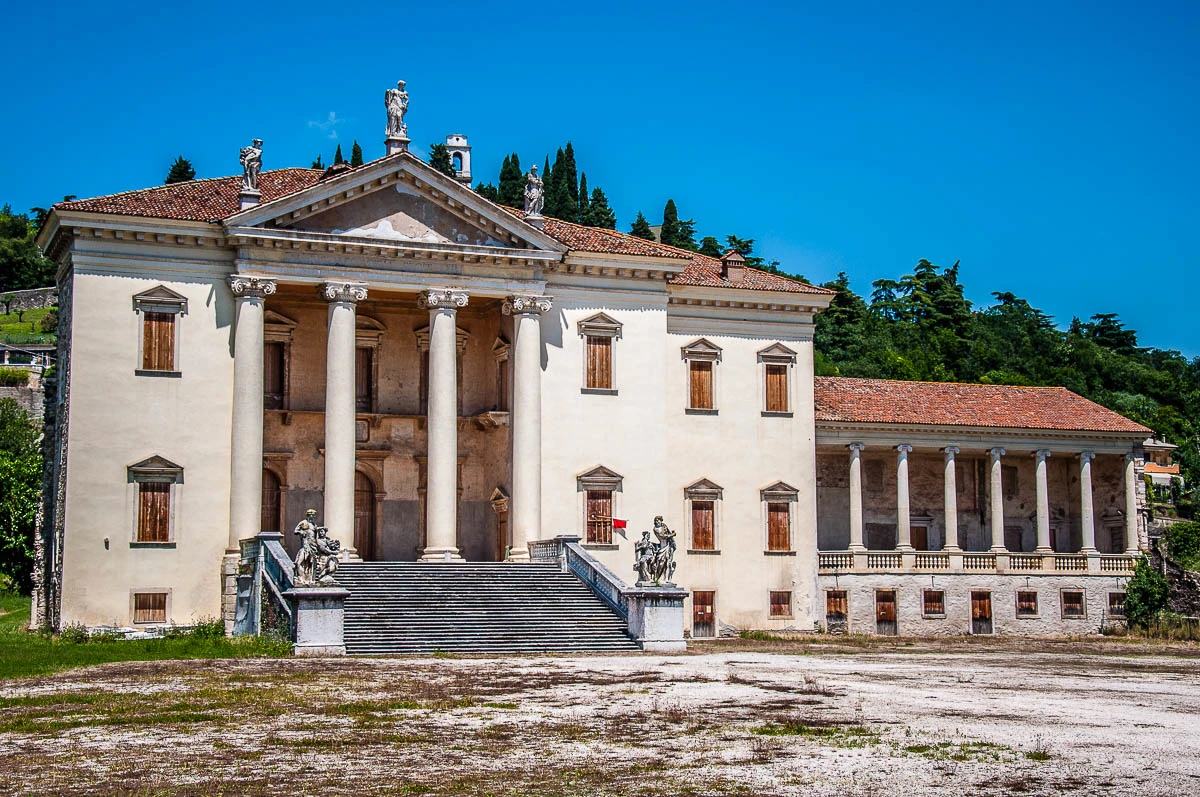
Montorso Vicentino is a tiny sleepy town within a short driving distance from Vicenza in the Northern Italian region of the Veneto.
Huddled at the base of a steep hill and surrounded by arable land, the town’s main sight is the Villa da Porto Barbaran. It is at this place that Luigi da Porto – in poor health and, some say, depressive mood – wrote his novel about Romeo and Juliet’s tragic love.
From the windows of his villa, da Porto could see two medieval castles – the Castle of Villa and the Castle of Bellaguardia. They crown the lush hills around the small town of Montecchio Maggiore which is less than six km away from Montorso Vicentino.
Gazing up at the castles and finding inspiration in his love troubles and a legend he had heard from his archer, da Porto started to write. Between 1512 and 1524 he penned his novel. It was dedicated to his cousin Lucina Sarvognan whom he was deeply in love with. In fact, in the dedication, he refers to Lucina as ‘the most beautiful and graceful’.
Luigi da Porto set the plot of his novel in Verona and came with the names of Romeo Montecchi and Giulietta Capuletti. It is thought that da Porto’s inspiration for Romeo’s name and surname and Juliet’s surname came from Dante’s Divine Comedy. Dante himself had mentioned the warring families of Montecchi and Cappelletti in verses 106-108 of Canto VI of Purgatory.
In his novel, da Porto outlined the young couple’s tragic love and ultimate death. In addition, he introduced the characters of Mercutio, Tybalt, Friar Laurence, and Paris.
The Villa da Porto Barbaran has changed appearances and hands several times since Luigi da Porto’s death. While it looks completely different nowadays, the locals claim that the ghost of the author still inhabits the place. In fact, photos purporting to show his presence as a white mist have circulated online for years.
The villa is not regularly open to the public. To visit it, you need to contact the local council and ask to be let inside. Otherwise, if you are visiting the Castles of Villa and Bellaguardia (which nowadays are simply known as Romeo and Juliet’s Castles), you can do the short drive from Montecchio Maggiore to Montorso Vicentino to see the villa from the outside.
You can see what the interior of Villa da Porto Barbaran is like in this video on its official Facebook page.
I had long wanted to see the villa for myself. The more I learned about Luigi da Porto and the origins of the story of Romeo and Juliet, the more I felt that unless I saw the villa, my Romeo and Juliet journey wouldn’t be complete. I finally made the trip there from Vicenza (where I was living at the time) last summer. It was a blistering hot day.
Under the bright sunlight, the villa stood proud, carefully guarding its secrets behind the closed shutters of its windows. It certainly is one of those places that have an imperceptible yet strong presence about them. I didn’t even need to close my eyes to imagine an anguished writer labouring over a manuscript while reliving in his mind his tragic love story.
2. Romeo’s and Juliet’s Castles – Montecchio Maggiore, Italy
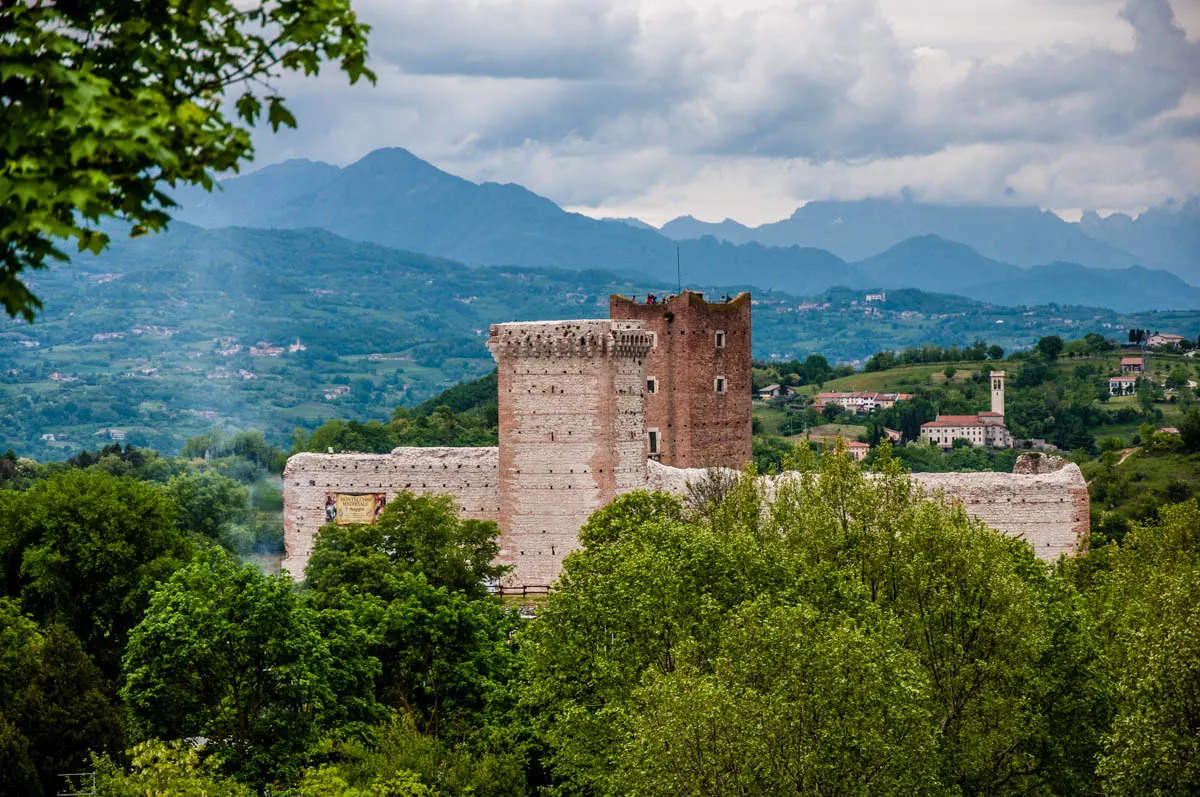
Two hilltop castles preside over Montecchio Maggiore – a small town in the Northern Italian region of the Veneto. Officially named Castello della Villa and Castello della Bellaguardia, their stories span many centuries. First mentioned in documents back in 1339, it is believed that they had been erected much earlier than that.
The castles have borne witness to several military campaigns. Their earliest defensive walls and buildings were almost totally destroyed.
Only two towers survived – one for each castle. The current walls and structures of the castles were built around them between 1354 and 1356 only to be damaged again about a century and a half later during the War of the League of Cambrai.
According to popular belief, these hilltop castles inspired Luigi da Porto to write the story of Romeo and Juliet. Gazing up at them from his villa in Montorso Vicentino, he penned his tragic novel.
Hence, locals customarily refer to the Castello della Villa as the Romeo’s Castle and to the Castello della Bellaguardia as the Juliet’s Castle.
The two castles are very interesting to visit and open splendid views over the surrounding countryside and hills. A road leads from Montecchio Maggiore up the hill first to Romeo’s Castle and then to its counterpart. There is no entry fee. There is a large car park next to Romeo’s Castle. The distance between the two castles is about 300 metres – a nice and easy hike on the paved road between lush vineyards.
There is a small church called San Valentino between the castles. In summer, Romeo’s Castle is used for open-air performances and film nights. Juliet’s Castle houses a seasonal restaurant. On the road leading to Juliet’s Castle, you will also spot the entrance to Le Priare – an underground complex of man-made caves formed during the centuries-long stone extraction that took place there.
For their history and the gorgeous views that they afford over the surrounding area, Romeo’s and Juliet’s Castles are a great spot to visit any time of the year. The castles truly come into their own during a yearly festival called La Faida. The festival is dedicated to Romeo, Juliet and their original author – Luigi da Porto.
For more details about Montecchio Maggiore, Italy, have a look here:
3. La Faida – Montecchio Maggiore, Italy
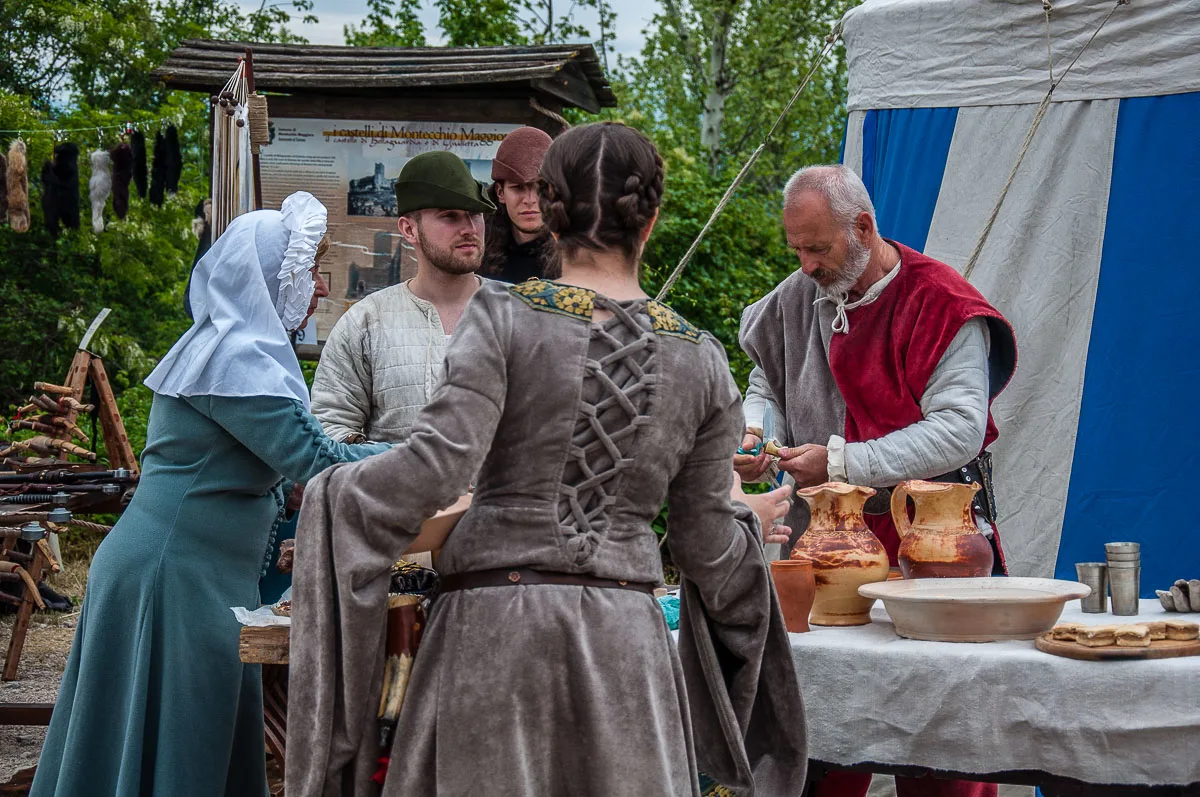
At the beginning of May each year, a large festival takes place around the Castles of Romeo and Juliet in the hills above the small Italian town of Montecchio Maggiore.
Known as La Faida, the festival celebrates the love of Romeo and Juliet and honours the original author of their story – Luigi da Porto.
For a weekend, a whole medieval village is built in the large space between the two castles. People dressed in medieval garb demonstrate ancient crafts like bookbinding and fresco painting. Knights in combat gear fight with swords and throw axes. Damsels in lavish dresses walk around in groups. Flag throwers perform under the amazed gazes of kids and adults alike. It’s a wonderful place to be. It truly feels like you have been transported back to the Middle Ages.
There is even a medieval beauty pageant and the winners are crowned Romeo and Juliet.
Visiting La Faida was one of the highlights of the six years I spent living in Vicenza in the North of Italy. The festival is a testament to how dedicated the Italians are to preserving their past, their crafts, traditions, and heritage.
4. Palazzo Chiericati – Vicenza, Italy
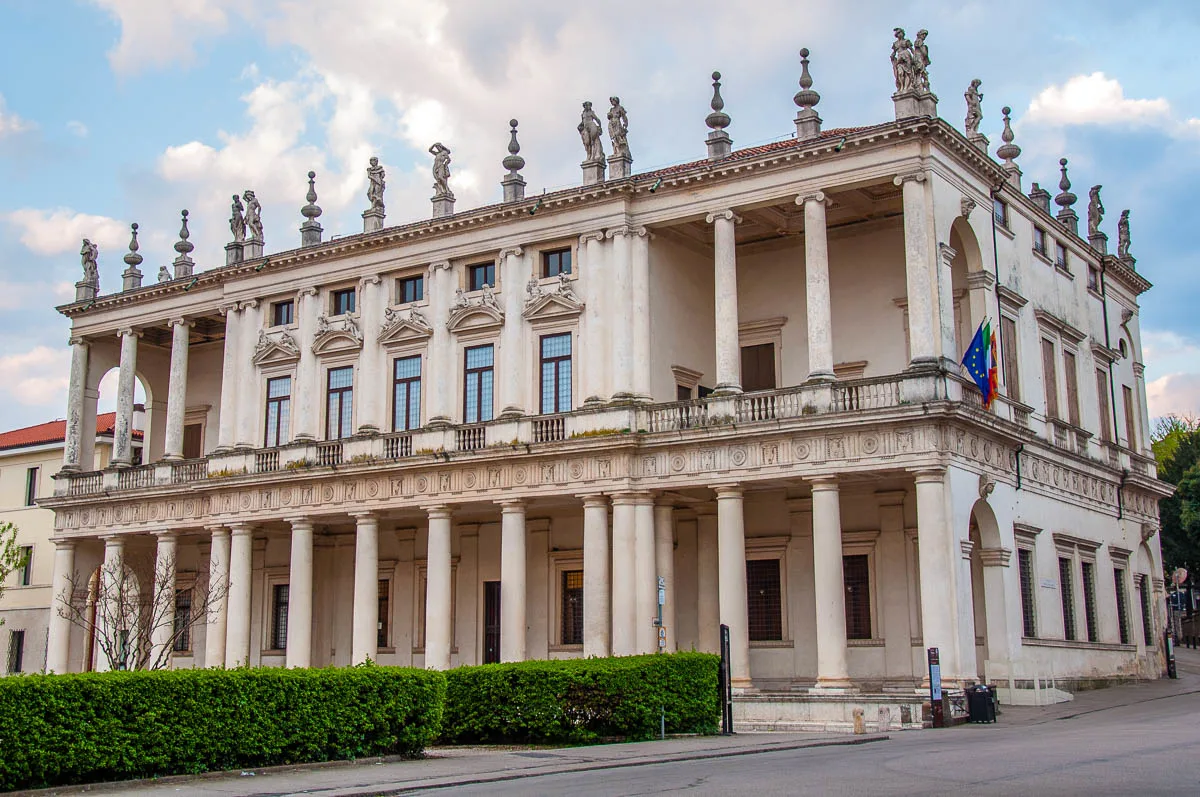
Palazzo Chiericati is a splendid palace in the city of Vicenza in the Northern Italian region of the Veneto. It’s a beautiful building with elegant loggias and a row of statues on the edge of its rooftop. Nowadays it houses the city’s art collection which is rich in masterpieces by Veronese, Tintoretto, and Tiepolo.
Palazzo Chiericati was designed by the eminent Renaissance architect Andrea Palladio in the 16th century. Its construction took a while and the palace was eventually finished in the second half of the 17th century. As such, it’s too new to be directly related to the origins of the story of Romeo and Juliet.
Yet, it was precisely in this palace in Vicenza that I first came across the name of Luigi da Porto and was spurred to find out more about him and his story. As part of the exhibition in Palazzo Chiericati, there is a striking portrait of a strapping man. His name is Ippolito da Porto – a famous military commander and member of the da Porto who have been one of the leading noble families of Vicenza since the 10th century.
The information displayed next to Ippolito’s portrait referenced Luigi da Porto as the original author of the story of Romeo and Juliet. This small mention started me on the journey of discovering more about the origins of the world’s most famous love story. Over the last few years, I made it my goal to find out as much as possible about it and to visit the many real-life settings where the literary characters of Romeo and Juliet were born and shaped throughout the centuries.
This blog post is the result of my personal interest and research on this captivating topic.
For more details about Palazzo Chiericati in Vicenza, Italy, have a look here:
5. Contra’ Porti – Vicenza, Italy
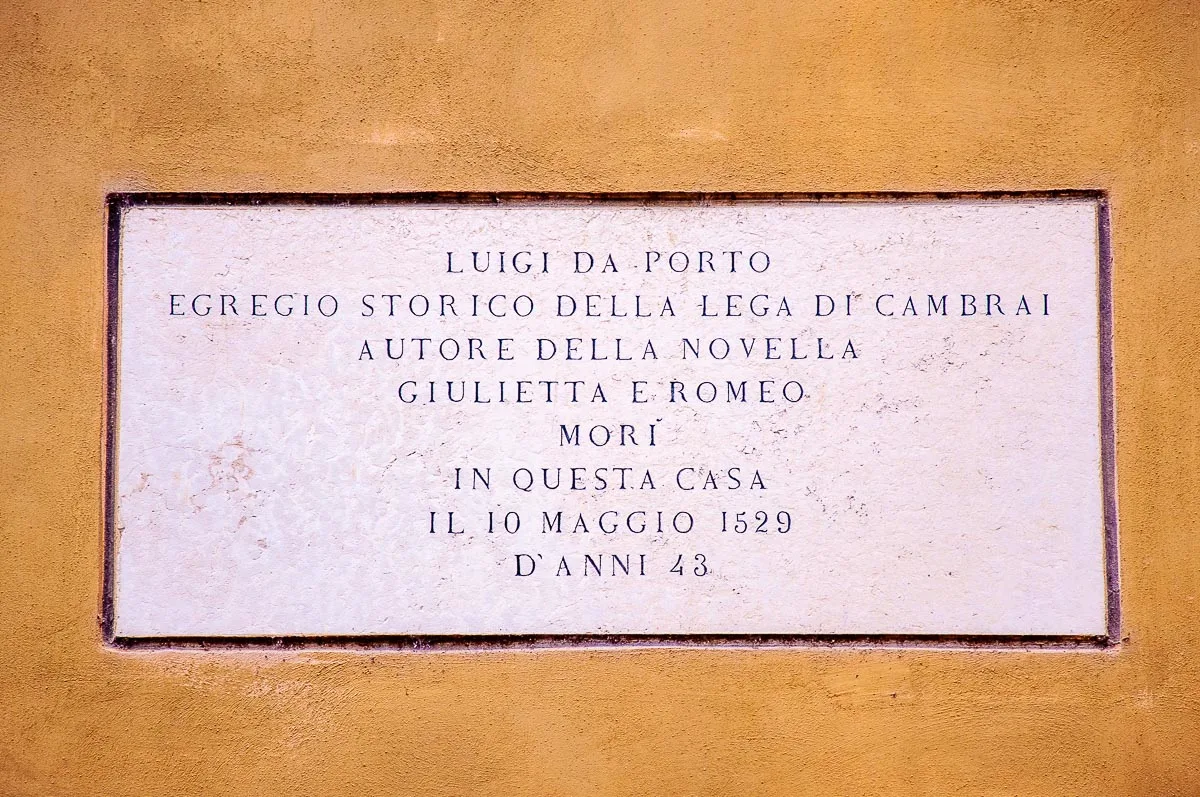
Contra’ Porti is one of the most beautiful streets in the city of Vicenza, Italy.
Flanked by palaces designed by the illustrious Renaissance architect Andrea Palladio, the street starts from Vicenza’s main artery – Corso Palladio – and leads to Bacchiglione – one of the rivers that flow through this small Italian city.
It is on this street, for example, that you will find the Palladio Museum. It explores the architectural heritage of the man who originated the Palladian architectural style. Just opposite Palladio Museum, stands Palazzo Thiene with its beautifully frescoed walls.
Continue walkding further down Vicenza’s Contra’ Porti and you will come across a small but important sight in the context of the Romeo and Juliet story.
Between the large ornate gates of numbers 15 and 17 on this beautiful street, you will see a plaque. It commemorates the fact that Luigi da Porto died in this house on 10th May 1529 at 43 years of age.
6. Church of Santa Corona – Vicenza, Italy
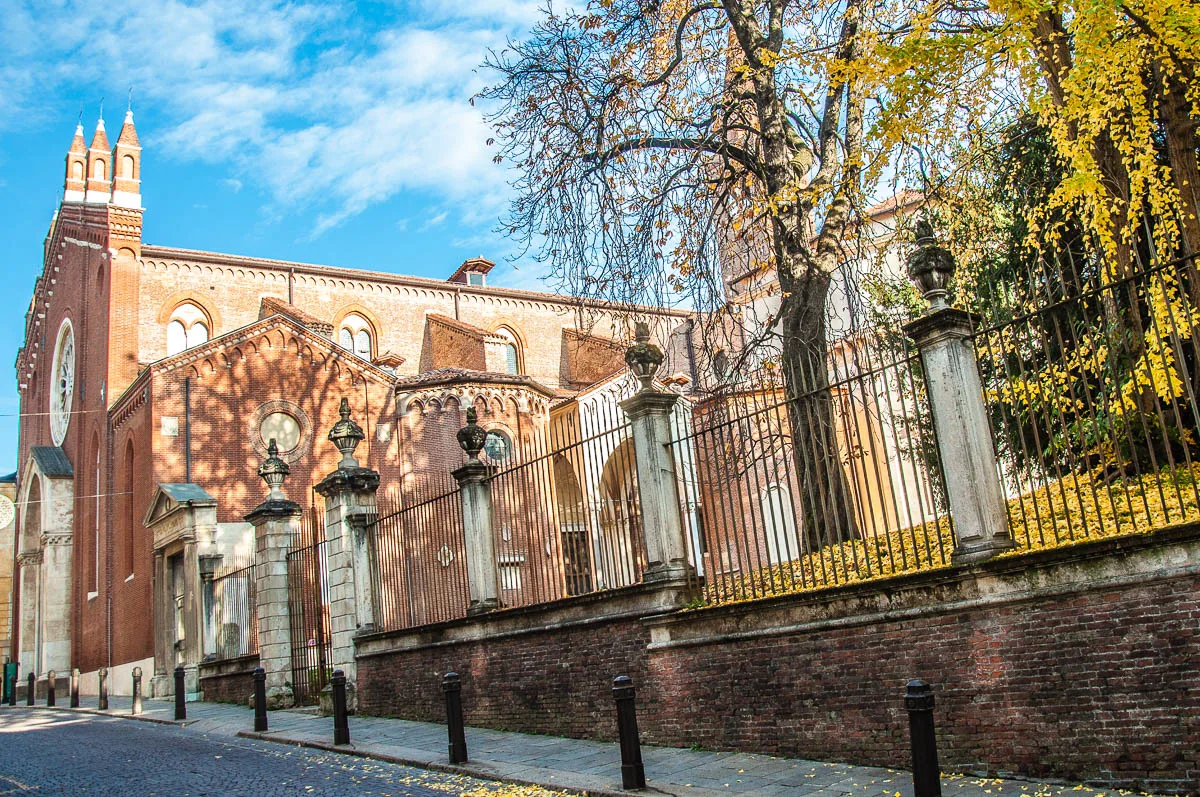
The Church of Santa Corona is one of the most interesting and beautiful places to see in Vicenza in Italy.
It was originally built in the 13th century to house a thorn from the Crown of Thorns that was placed on the head of Jesus during His crucifixion. The Holy Thorn had been given to the Bishop of Vicenza by the King of France.
For many centuries, the Church of Santa Corona was Vicenza’s main place of worship. Nowadays, its Gothic building houses countless priceless works of art by the likes of Paolo Veronese and Giovanni Bellini. It also has a spectacular pietra dura altar and intarsia choir stalls with elaborated patterns and detailed scenes made entirely of wood.
Luigi da Porto is laid to rest here. When you enter the Church of Santa Corona, look to the left and you will see his stone sarcophagus. It is under a large painting of a Nursing Madonna by Bartolomeo Montagna. A small sign indicates that this is the final resting place of the original author of the story of Romeo and Juliet.
7. Juliet’s House – Verona, Italy
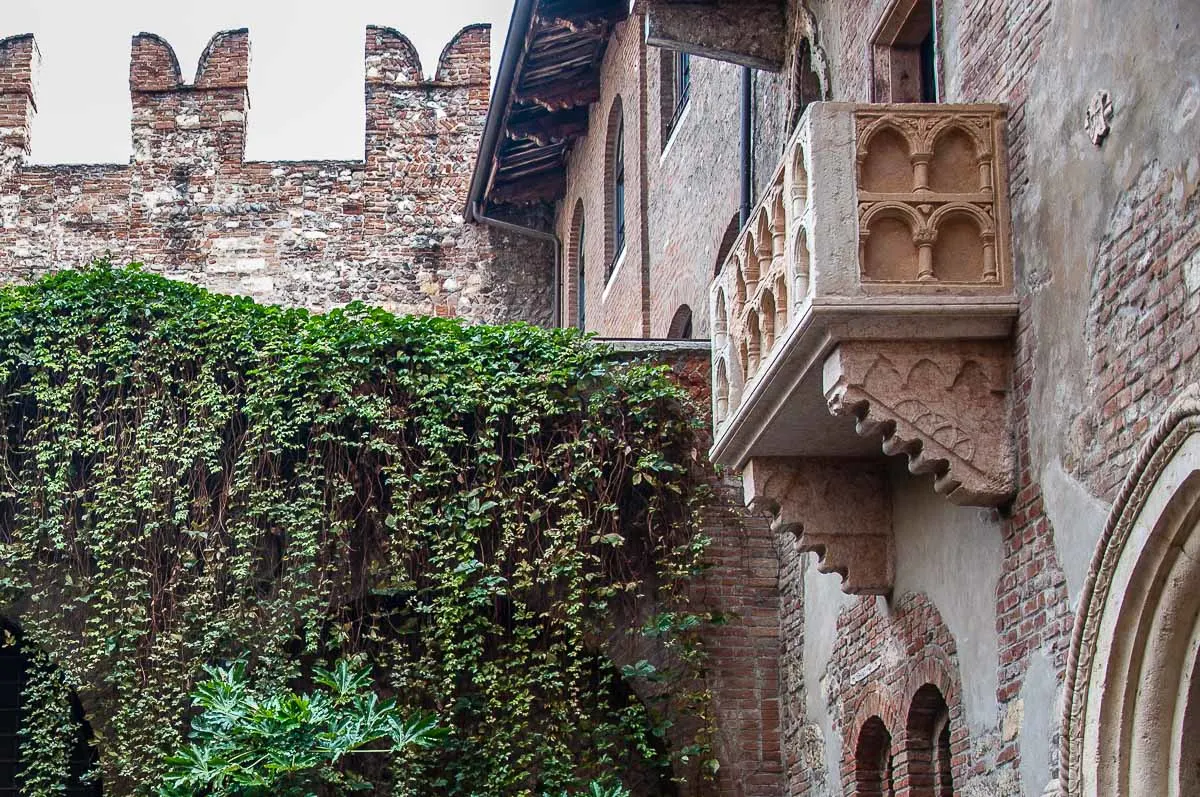
Juliet’s House is one of Verona’s and Italy’s major tourist sights. Based on data from 2018, its courtyard with the famous statue of Juliet attracts two million people each year while the visitors of the actual house are over 350,000.
Juliet – for being a character of fiction – has never actually lived here. Yet, such is Juliet’s influence on our collective mind that many perceive this house with its famous balcony to be the real, authentic thing.
Luigi da Porto chose Verona as the stage for his story about Romeo and Juliet. Some say this was because he heavily borrowed from a local legend about two young lovers that had been told to him by his archer Pellegrino. Others are convinced that da Porto took the names and the setting from Dante’s Purgatory where the warring Montecchi and Cappelletti are mentioned in Canto VI.
Shakespeare kept the Verona setting in his worldwide famous play, too. Although there are no official records of the English bard ever visiting Italy, he must have heard of the city’s fabled beauty and felt that fair Verona would be the right stage for the drama to unfold.
Throughout the years that followed, Verona had made the most of this. The Italian city refers to itself as the City of Love. It has also set up everything in place to make us suspend belief and simply accept that Romeo and Juliet did indeed live here and that there are traces of them all over the city.
Instrumental in this endeavour was Antonio Avena – director of Verona’s Civic Art Museums from 1920 to 1955. It was under his direction that Juliet’s House and Juliet’s Tomb were arranged as tourist sights.
Juliet’s House is a few steps away from Piazza delle Erbe – one of the most beautiful squares in Verona’s historic centre. This is a 13th-century building that has been modified numerous times since it was originally built. This is where the family Cappelletti lived in the Middle Ages. Their coat of arms – a hat – can still be seen on the entrance arch of the house’s courtyard. The evolution of the name from Cappelletti to Capulets seems perfectly logical in terms of poetry and linguistics.
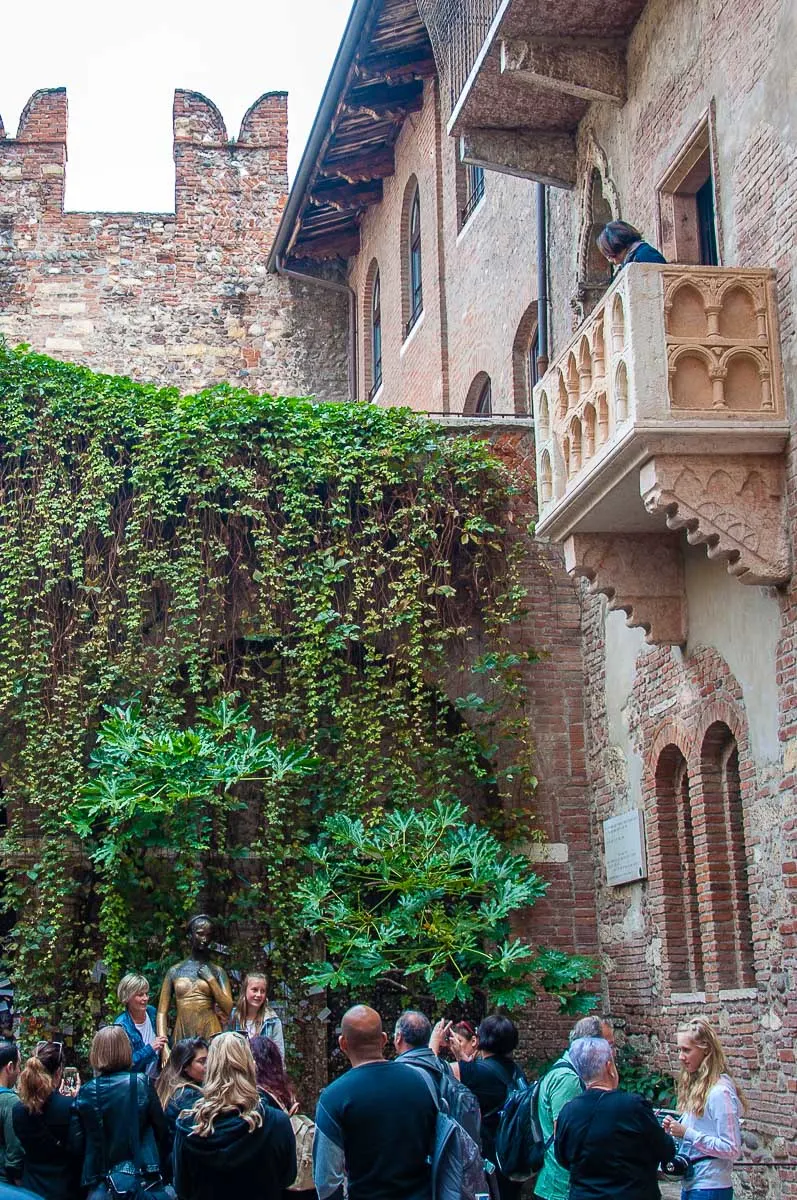
The famous balcony was added to Juliet’s House less than a century ago under Avena’s instructions. They say that it’s made of an old sarcophagus that was sawn in two. Yet, this hasn’t stopped hundreds of Romeos to propose to their Juliets standing on this balcony during a visit to Juliet’s House in Verona. One St. Valentine’s Day – a ripe time for romance – I spent half an hour milling around Juliet’s House’s cobbled courtyard. In this short span of time, there were three proposals on the balcony with the crowd below clapping and cheering after each one.
It’s funny to think that there is no mention whatsoever of an actual balcony in Shakespeare’s original play nor in the stage directions that he wrote. Even better, the word ‘balcony’ only started to be used in the English language after the playwright’s death. According to the original folio of the play, Juliet had to appear ‘above at a window’. This article in The Atlantic explains in great detail how the scene was changed in the centuries that followed to include a balcony.
While it’s easy to dismiss Juliet’s House as a touristic gimmick, I would advise you to visit it for yourself. Not just its courtyard but the actual house. It’s a great example of a fortified medieval abode, more a tall tower than a typical house. It reflects the type of buildings in which the rich merchants of the Middle Ages in Italy would live. Throughout the centuries, the house also served as a hospital and as a stall for horses with adjacent rooms to rent.
In fact, when the famous English writer Charles Dickens visited Verona during his Italian travels in 1844/1845, this is what he wrote about Juliet’s House: ‘It was natural enough, to go straight from the Market-place, to the House of the Capulets, now degenerated into a most miserable little inn.’
Don’t let Dickens’ description put you off though. Many things have changed over the last two centuries or so. Inside Juliet’s House nowadays you can see the big hall – the so-called Salone delle Feste – where special ceremonies and even weddings take place. It is from this hall that you can access the small balcony and have a look at the courtyard from above. Another interesting room to see in Juliet’s House is the Camera da letto – the bedroom which is outfitted with the bed used in Franco Zeffirelli film ‘Romeo and Juliet’.
On your way out, make sure that you pay homage to the local superstition. Namely, that if you touch the right breast of the statue of Juliet, you will be lucky in love. The original bronze statue has been touched so many times that its right breast not only is discoloured but now it bears a hole. While it’s kept safely in the lobby of Juliet’s House, a replica of the statue is placed in the courtyard outside.
8. Romeo’s House – Verona, Italy
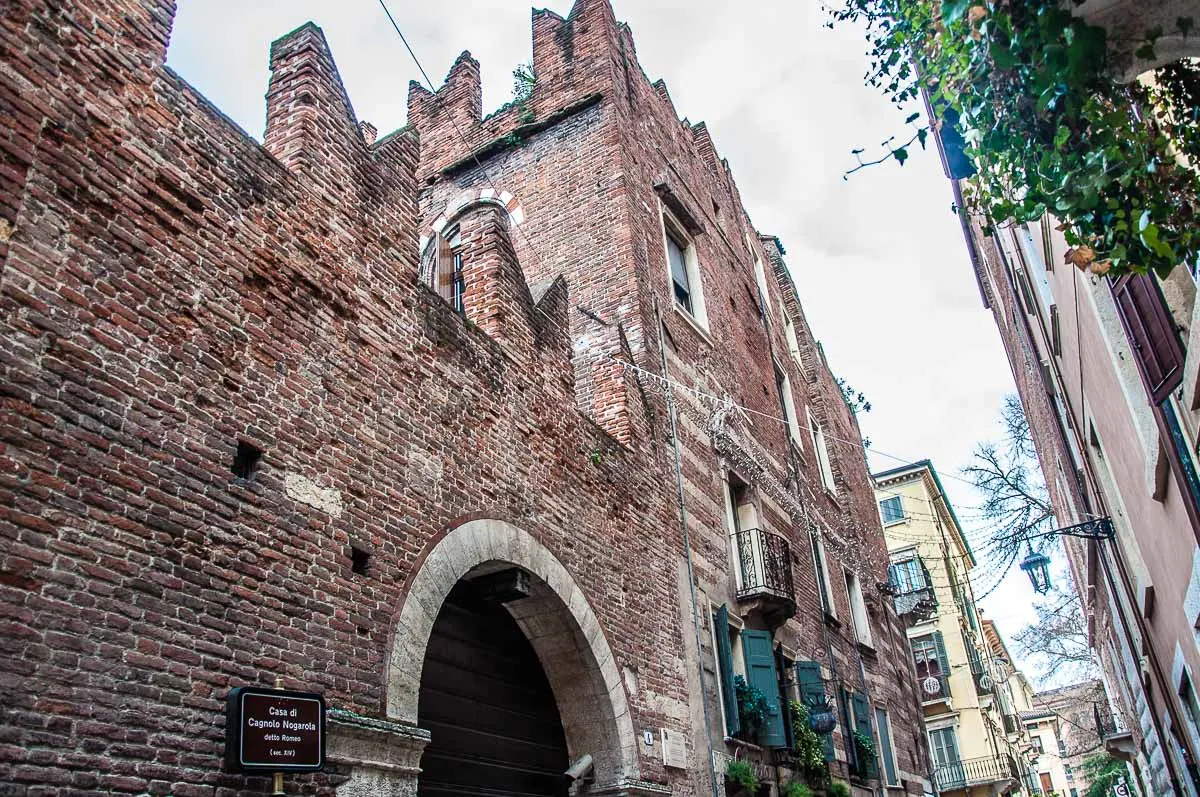
Romeo’s purported house in Verona is a short distance away from Juliet’s abode. You will find it right around the corner from the Scaliger Tombs. The latter are Gothic funerary monuments that are one of Verona’s biggest and authentic historic sights.
The Scaliger Tombs are the final resting place of the rulers of Verona from the della Scala medieval family. In fact, Luigi da Porto’s Romeo and Juliet story takes place during the rule of Bartolomeo della Scala (1301-1304).
Romeo’s House is a massive fortified building with a huge gate and battlements on top of its facade. It’s a private house, so it’s not open for visits. Allegedly, many ancient chronicles identify it as the house where the real-life Montecchi used to live in the Middle Ages. The Montecchi (called Montagues by Shakespeare) were an important merchant family. They were Ghibellines (in other words, supporters of the Holy Roman Emperor against the Pope) and took active part in the struggles for power over Verona.
There are small plaques affixed to the wall of Romeo’s House. One of them has a quote from Shakespeare’s Romeo and Juliet, whereas the other quotes Canto VI from Dante’s Purgatory.
Line 106 of it makes a specific reference to the Montecchi and Cappelletti – the two families whose ‘ancient grudge’ would become immortalised in Lugi da Porto’s and Shakeaspeare’s literary works.
9. Juliet’s Tomb – Verona, Italy
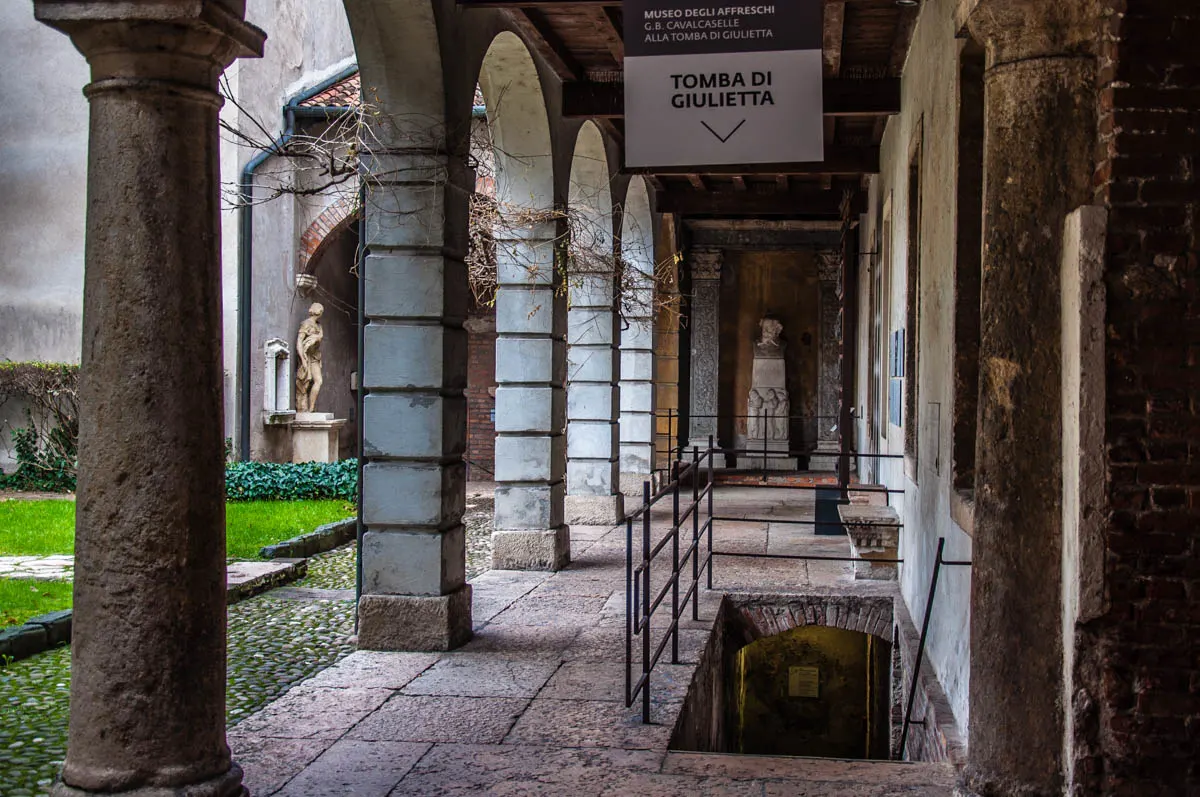
Juliet’s Tomb is another must-see sight on this itinerary taking in the real and literary settings of the Romeo and Juliet story.
It is housed in the crypt of the Church of San Francesco al Corso which is part of a former Franciscan monastery (nowadays converted into an excellent museum preserving many beautiful frescoes). You will find it just outside Verona’s medieval defensive walls. Curiously enough, the street on which the ex-monastery stands nowadays is called Via Luigi da Porto. This street is perpendicular to Via Shakespeare! You have to give it to the council of Verona for naming these two streets so appropriately.
The Church of San Francesco al Corso was built in 1230 at the spot where St. Francis of Assisi had allegedly stayed during his visit to Verona in 1220. In Luigi da Porto’s novel, Romeo and Juliet’s secret wedding takes place in this church. It is also mentioned there that the tomb of the Cappelletti, Juliet’s ancestors, is in the cemetery next to the church. It is in this tomb that, according to da Porto, Juliet is buried after taking the sleeping powder given to her by Friar Lorenzo. This is also where first Romeo and then Juliet tragically die.
Again in da Porto’s words, when the Prince of Verona – Bartolomeo della Scalla – is informed of their death, he orders that the bodies of Romeo and Juliet be placed on two carpets in the Church of San Francesco. Their fathers, consumed by their shared grief, embrace. A handsome monument is then erected with the cause of the two lovers’ death engraved on it. And Romeo and Juliet are buried with great and solemn funeral pomp.
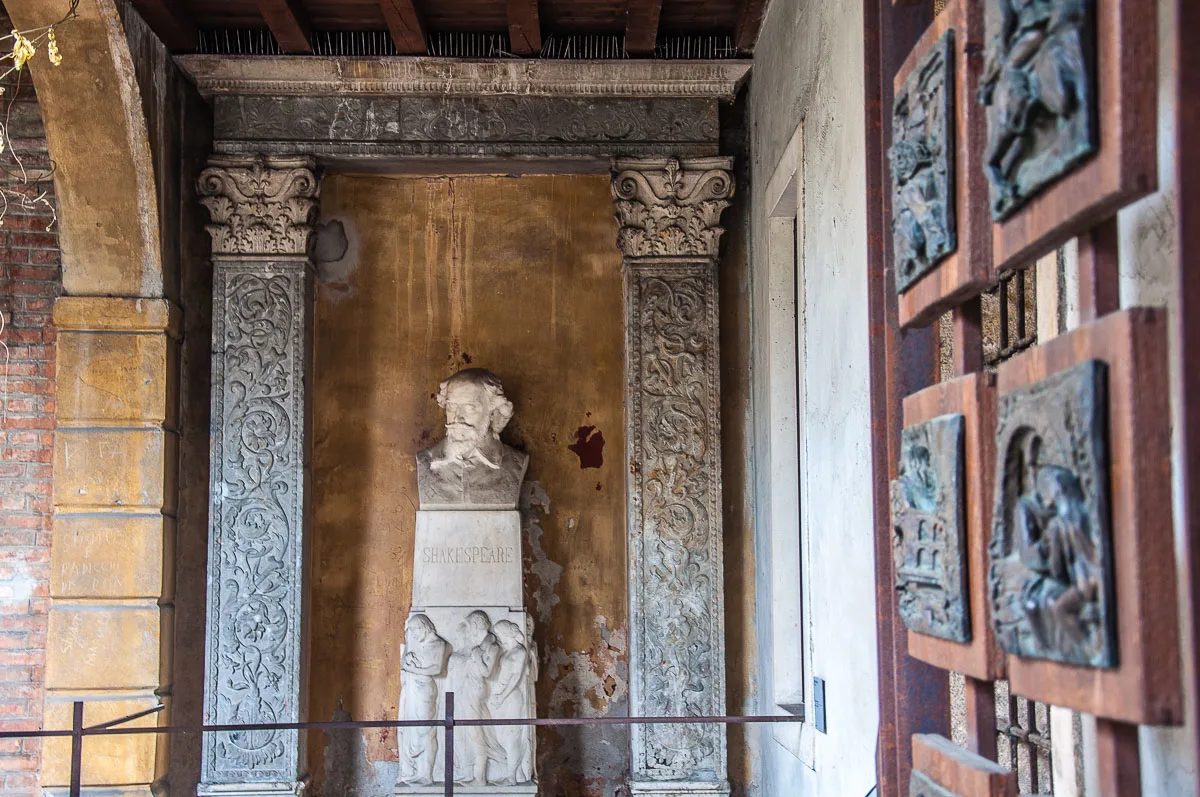
Da Porto doesn’t specify where exactly their final resting place was. Yet, for centuries, the idea has prevailed that this once again had been the cemetery next to Verona’s Church of San Francesco. For many years the place attracted droves of pilgrims, curious to see the settings of the famous love story. At some point, Juliet’s sarcophagus – plain and made of red Verona marble – had been unearthed, emptied of its contents and used as a receptacle for the water from the monastery’s well. The monastery then became a convent before being abandoned around mid-19th century.
Still, pilgrims continued to flock, among them many famous writers like Byron, Mary Shelley, and Charles Dickens. For a brief period of time, it allegedly became fashionable to have jewellery fashioned out of pieces broken off the red marble of Juliet’s sarcophagus. In 1822, Princess Maria Luisa of Austria famously had a set of bracelets and a necklace (and some say, even earrings) made from it. Nowadays, you can see that the sarcophagus is damaged and large chips have been chiselled away from its sides.
In 1937, under the guidance of Antonio Avena – then director of Verona’s Civic Art Museums – Juliet’s sarcophagus was placed in the small crypt of the Church of San Francesco and the environment was cleaned and organised. Known as Juliet’s Tomb, I found this quite a touching sight to visit in Verona. With a bust of Shakespeare placed near the exit of the crypt and a large work of art illustrating in ten panels the main moments from the story of Romeo and Juliet, it is a nice and peaceful place.
It makes for a rather memorable visit. Especially, if you want to exercise your romantic right to believe that this, indeed, is the place where Romeo and Juliet celebrated their love in getting married to each other before meeting their tragic end.
10. Other Romeo and Juliet Sights – Verona, Italy

There are a few other sights in Verona with a connection to the story of Romeo and Juliet. Here is a shortlist:
- Volto Barbaro – this is the place of the duel between Tybalt and Mercutio. It’s behind the splendidly frescoed Mazzanti Houses that face Verona’s Piazza delle Erbe.
- Palazzo Carlotti – this large baroque palace on Corso Cavour was built on the alleged place where Romeo kills Tybalt with his sword. A small plaque and a bronze bas-relief are affixed to the palace’s facade recalling this dramatic scene from the story of Romeo and Juliet.
- Portoni della Bra – with a small bronze bust of William Shakespeare and a plaque with a quote from his play ‘Romeo and Juliet’. Presumably, once banished from Verona after killing Tybalt, Romeo must have left the city through the gate which existed at this spot as early as the 13th century.
- Juliet Club – made famous by the Hollywood movie ‘Letters to Juliet’, this is the club that for close to a century has been replying to letters sent to Juliet from all over the world seeking advice in matters of love.
- Verona in Love – a city-wide festival taking place each February in Verona.
- Baci di Romeo and Baci di Giulietta – literally ‘Romeo’s Kisses’ and ‘Juliet’s Kisses, these are delicious cookies that are handmade in Verona. Romeo’s version is made of almond paste and buttercream and Juliet’s is made of hazelnut paste and chocolate cream. I loved buying them from Pasticceria de Rossi (no relation to me) – one of Verona’s best historic patisseries.
11. Mantua, Italy
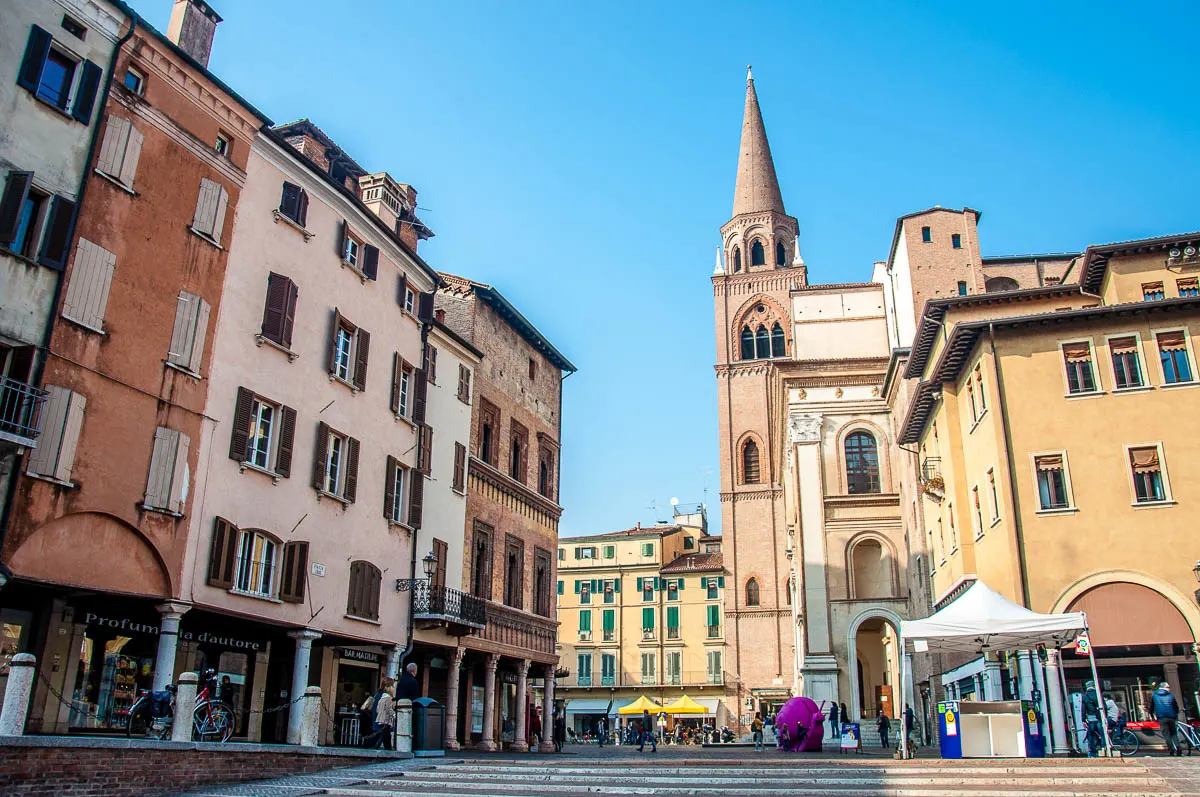
Mantua is a beautiful fortified city surrounded on three sides by manmade lakes. It’s in the Northern Italian region of Lombardy and less than an hour away by train from Verona. One of Italy’s historic city-states, Mantua was ruled by the House of Gonzaga from the 14th to the beginning of the 18th centuries.
Nowadays, Mantua makes for a wonderful day trip with its imposing Ducal Palace, cobbled centre, and operatic heritage for it is in this city that Giuseppe Verdi’s famous opera Rigoletto is set.
Mantua is also one of the settings in the tragic story of Romeo and Juliet. This is the city to which Romeo heads to after he is banished from Verona for the killing of Tybalt. While his time in Mantua starts on a happy note, as Romeo receives a letter from Juliet and has a happy dream about her, soon several events take place that set in motion the tragic end. For it is in Mantua that Romeo is wrongly told that Juliet has killed herself. And it is also in Mantua that the apothecary sells to Romeo the poison that would ultimately kill him.
So, you can say that Mantua has a deep and important link to the story of Romeo and Juliet. However, the city is not just a literary setting in it. Mantua is connected to the actual process that shaped the world’s most famous love story as we know it today. It is where one Matteo Bandello lived and worked in the court of the Duques of Gonzaga in the 16th century.
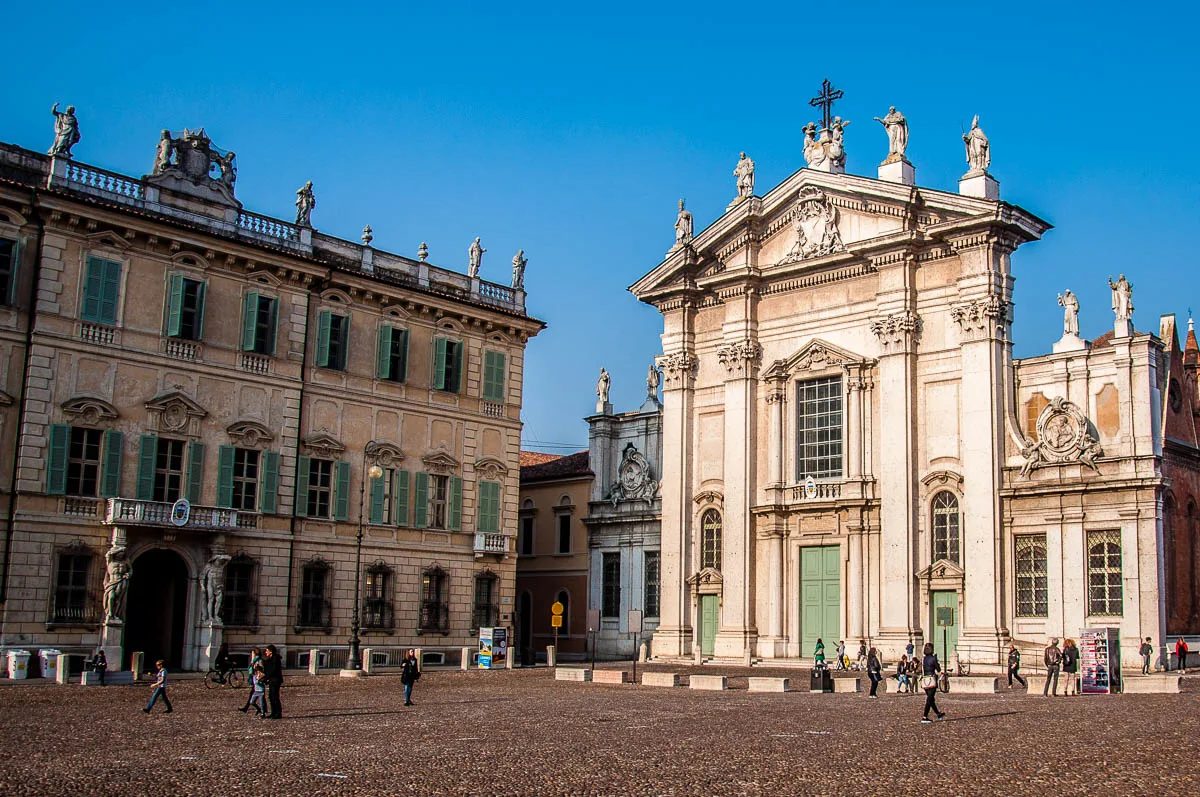
Just like Luigi da Porto, Bandello was a soldier and a writer. He was also a monk and the most famous writer of short stories at the time. Bandello re-wrote da Porto’s novel and gave it the name La sfortunata morte di dui infelicissimi amanti che l’uno di veleno e l’altro di dolore morirono con vari accidenti (in English, The Unfortunate Death of Two Most Wretched Lovers, One of Whom Died of Poison and the Other from Pain with Various Other Incidents).
Bandello introduced the character of the Nurse, emphasised Romeo’s love for Rosalind before his fateful meeting with Juliet, and made Juliet kill herself with a dagger whereas in da Porto’s version she dies by holding her breath.
It is thought that Matteo Bandello’s writings have inspired several of William Shakespeare’s plays. Most notably, ‘Much Ado About Nothing’ and ‘Twelfth Night’. So, it’s not a stretch of the imagination to think that Bandello may be the link or one of the links between the story written by Luigi da Porto and Shakespeare’s famous play.
Visiting Mantua is a great idea if you have an interest in seeing the real and the literary settings of the story of Romeo and Juliet. The historic centre of the city seems frozen in time. It gives you a great understanding of what Italian city-states were like between the end of the Middle Ages and the Italian Renaissance.
And while the address of the apothecary’s house and shop is not known, walking through Mantua’s historic centre and trying to imagine where it may have been is a great way to explore this Italian city under the star of Romeo and Juliet.
For more details about Mantua, Italy, have a look here:
- Pont 8 – Day Trips from Verona, Italy – 16 Destinations in Italy to Fall in Love with (With Travel Times and Train Tips)
- Point 6 – 18 of the Best Cities to Visit in Northern Italy (With Travel Tips and Nearest Airports)
12. William Shakespeare’s Birthplace – Stratford-upon-Avon, England
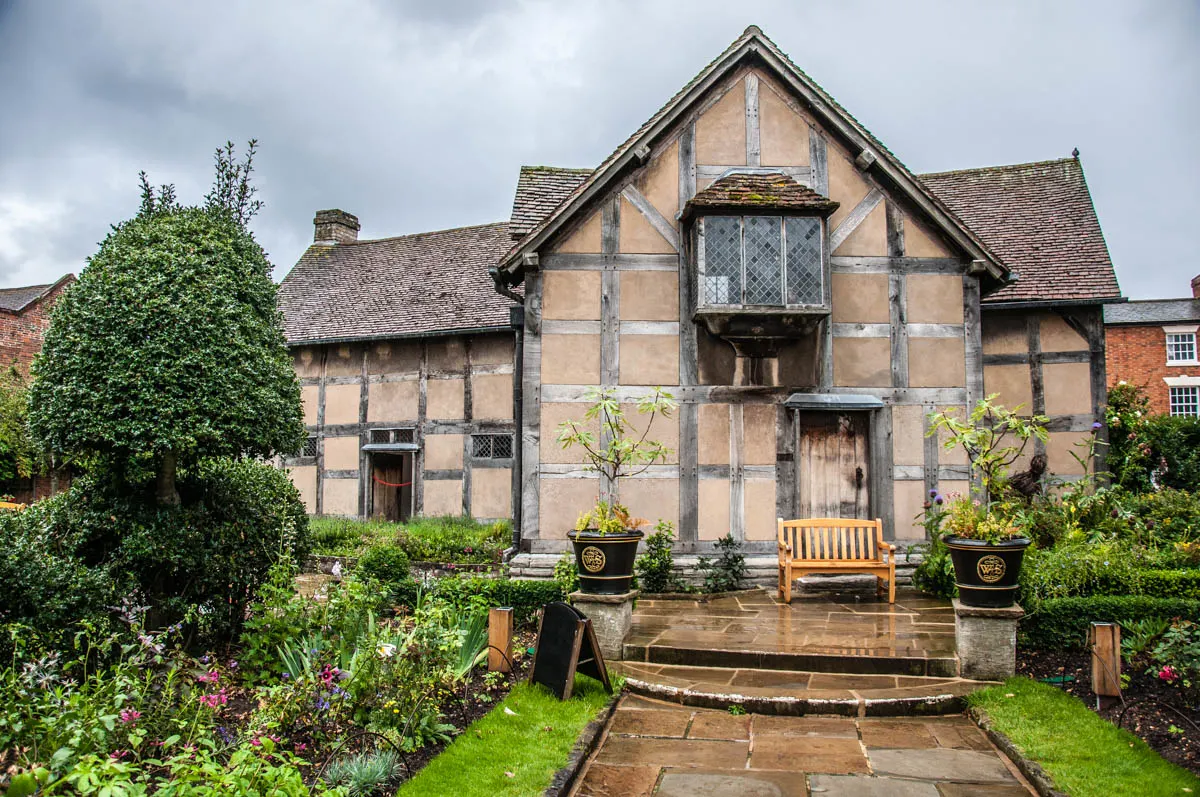
Visiting the house where William Shakespeare’s family lived when he was born is a great way to learn more about the greatest English playwright and poet. Shakespeare’s father, John, lived and worked in the house for fifty years. He and his wife – Mary Arden – had eight children there with William born on 23rd April 1564. He also inherited the house after his father’s death.
Shakespeare’s birthplace is an atmospheric, centuries-old building on Henley Street in the heart of the pretty English town of Stratford-upon-Avon. It has been tastefully turned into a tourist site and together with the other four properties connected to the life and work of Shakespeare in the town, it attracts close to a million visitors each year.
The garden at the back of the house is particularly lovely.
Visiting the places that are intrinsically connected to the lives of the authors of the different versions of the story of Romeo and Juliet is a great way to learn about them as people, to better understand how they lived their lives, and what inspired their writing.
13. London, England
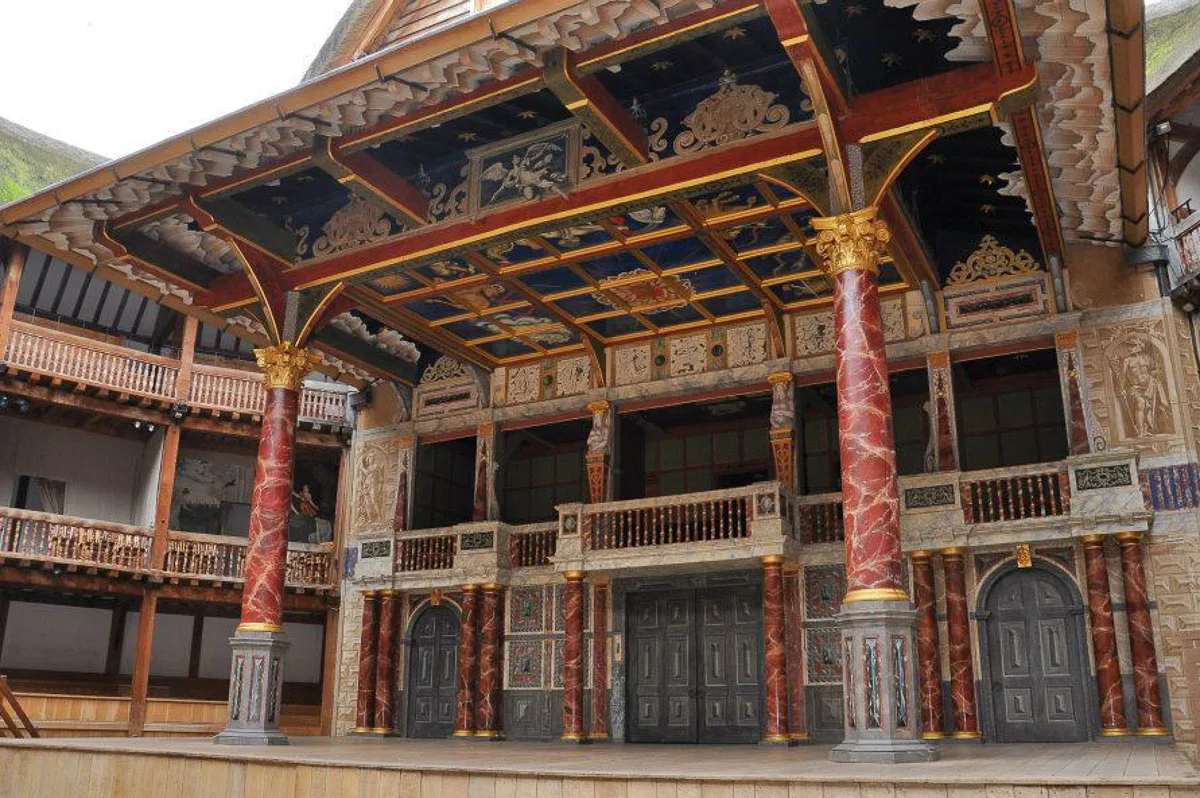
London has close connections to the story of Romeo and Juliet. It was in the English capital that William Shakespeare wrote his play. As recently as 2019, a theatre historian succeeded in identifying the exact location of the house in which the Bard of Avon composed Romeo and Juliet. Apparently, nowadays, there is an office block at its place.
It was also in London that the ‘Romeo and Juliet’ play was staged for the first time in the last few years of the 16th century. First in the Theatre and then in the Curtain – two of the first playhouses built in London.
The Theatre was dismantled in 1597 and then put together under a new name – the Globe. Today, you can visit Shakespeare’s Globe in London again. It was opened in 1997 about 230 m away from where it had originally stood. The theatre stages Shakespeare’s plays – with ‘Romeo and Juliet’ among them – in an environment that closely replicates the atmosphere of the era. It’s a wonderful place to visit for a guided tour or performance.
In Conclusion
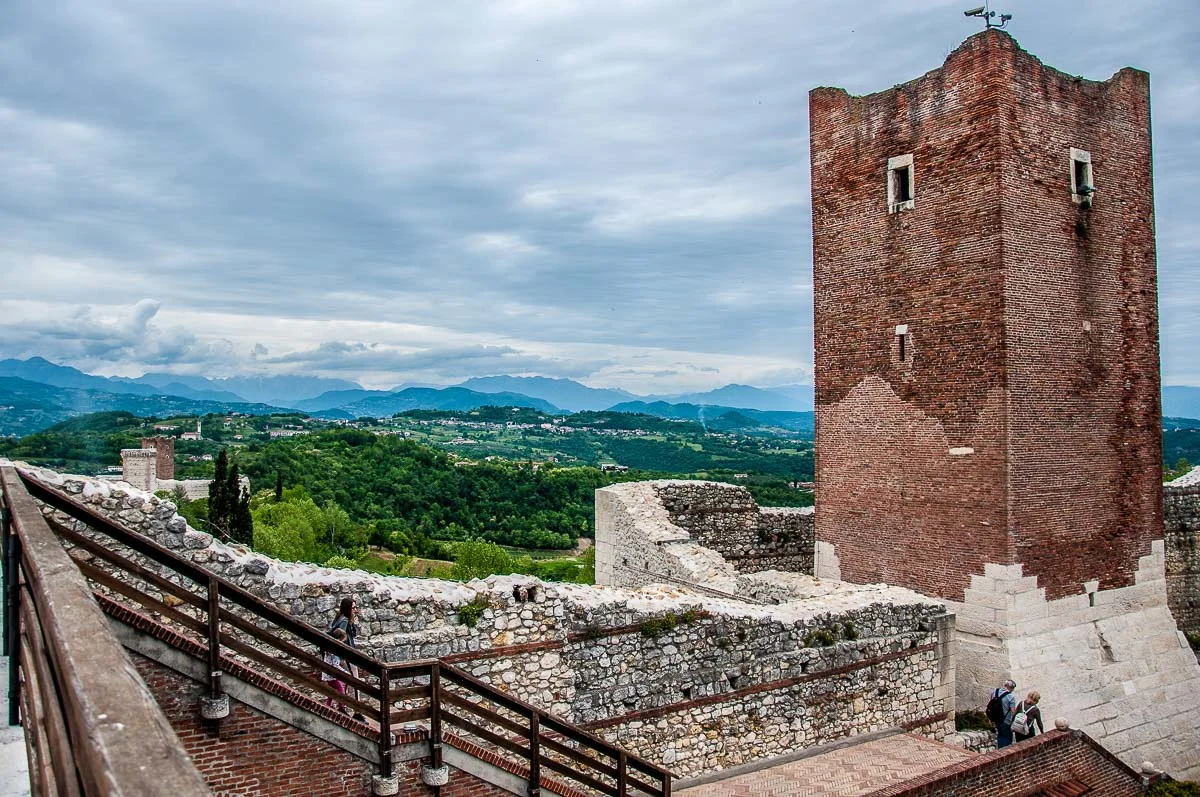
The story of Romeo and Juliet is without a doubt, the most famous love story in the world.
While nowadays William Shakespeare is universally thought of as its author, tracing the origins of Romeo and Juliet reveals a much more complicated reality. Since finding out that the original author of Romeo and Juliet was a nobleman from the Italian city of Vicenza, I have been on a quest to visit as many of the places that played a role in his writing and in the shaping of the story as we know it nowadays.
The above blog post is the result of this personal quest of mine. While it’s by no means exhaustive, it covers in some detail several of the real-life and literary settings of the story of Romeo and Juliet. All of the places mentioned above can be visited by anyone with an interest in travel and curious destinations.
I hope that this blog post will galvanise you to find out more about the origins of the story of Romeo and Juliet and that will lead you to visit many if not all of the places covered above.
Thank you for reading!
More Helpful Romeo and Juliet Info for You
Verona: My Visit to the Juliet Club, 20 Best Things to Do in One Day, Video of Juliet’s House, Video of the Juliet Club
Other Romeo and Juliet Destinations: Vicenza, Montecchio Maggiore
More Helpful Italy Info for You
Northern Italy: 18 Best Cities to Visit
Veneto: Best Cities to Visit, Top 15 Places, 30 Adventures, 15 Most Colourful Places
Best of Italy: Italian Piazzas, Italian Food, Italian Markets, Italian Coffee Culture
Lake Garda: Best Towns, Nearest Airports, Travel Options, Lake Garda with Kids
Lake Como: Things to See
Venice: Hidden Gems, Boats in Venice, Day Trips from Venice
Verona: Things to Do in One Day, Day Trips from Verona
Padua: Things to Do in One Day, 101 Facts About Padua, 10 Reasons to Visit Padua, Day Trips from Padua
Vicenza: Things to Do, Day Trips from Vicenza
Thank you for reading! Please, leave me a comment, pin the image below or use the buttons right at the top and at the end of this blog post to share it on social media.
For more useful information like this, please, like my blog’s page on Facebook and subscribe to my strictly no-spam newsletter.
